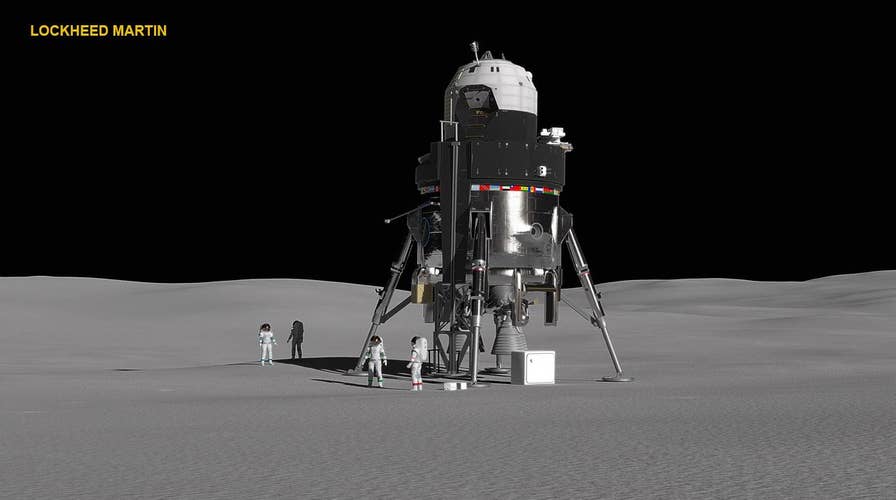Lockheed Martin unveils new lunar lander
Lockheed Martin has unveiled a new lunar lander prototype, the Mars Base Camp Precursor Lunar Lander, that would let astronauts stay on the Moon for up to two weeks. The spacecraft would use the Lunar Orbital Platform-Gateway as its home base, which NASA said will start building near the Moon in 2022.
Lockheed Martin has unveiled a new lunar lander prototype that would let astronauts stay on the Moon for up to two weeks.
The spacecraft, known as the Mars Base Camp Precursor Lunar Lander, would use the Lunar Orbital Platform-Gateway as its home base, which NASA said will start building near the Moon in 2022, Space.com reports.
"NASA asked industry for innovative and new approaches to advance America's goal of returning humans to the Moon, and establishing a sustainable, enduring presence there," said Lisa Callahan, vice president and general manager of Commercial Civil Space at Lockheed Martin Space in a press release. "This is a concept that takes full advantage of both the Gateway and existing technologies to create a versatile, powerful lander that can be built quickly and affordably. This lander could be used to establish a surface base, deliver scientific or commercial cargo, and conduct extraordinary exploration of the Moon."
TRUMP WANTS TO SEE NASA BOOTS ON THE MOON
In conjunction with the Lunar Gateway, the Mars Base Camp Precursor Lunar Lander would take astronauts and 1.1 tons of cargo to the Moon's surface, according to a Lockheed white paper on the topic. From there, they could stay on the lunar surface for two weeks then go back to the Gateway with no need for refueling.
It would however need to be refueled between missions, potentially using water from the Moon's surface.
"The Gateway is key to full, frequent and fast reusability of this lander," said in a statement Tim Cichan, the space exploration architect at Lockheed Martin Space who presented the lander concept at the International Astronautical Congress (IAC).
Cichan continued: "Because this lander doesn't have to endure the punishment of re-entering Earth's atmosphere, it can be re-flown many times over without needing significant and costly refurbishment. That's a major advantage of the Gateway and of a modular, flexible, reusable approach to deep space exploration."
In August, researchers found frozen water on the Moon for the first time. The water could be broken down and eventually used for rocket fuel or for oxygen to breathe, according to scientists, who noted at the time that the discovery was significant.
LIFE ON THE MOON? NEW STUDY ARGUED LIFE COULD HAVE EXISTED ON THE LUNAR SURFACE
Lockheed said that the lander design uses technology developed for its Orion Multi-Purpose Crew Vehicle, a vehicle it says is "the only spacecraft designed for long-duration, human-rated deep space exploration." Eventually, the Orion will take humans beyond low Earth orbit to the Moon and eventually Mars, Lockheed notes.
It's expected that the Mars Base Camp Precursor Lunar Lander could be running by the later part of next decade. In an August speech, Vice President Mike Pence made clear that returning to the Moon is a top priority for the U.S., an objective previously put forth by the Trump administration.
“We’re not content with just leaving behind footprints,” he said, during the 30-minute speech, reiterating the Trump administration’s objective of “establishing a permanent presence around and on the Moon.”
The VP also described the mighty Space Launch System (SLS) and Orion spacecraft that will be used to carry U.S. astronauts on epic missions over the coming years. “The SLS will be the largest and most powerful rocket ever built — all this energy, all this force, will lift American astronauts to space aboard the Orion capsule,” Pence explained.
NASA NAMES NINE 'AMERICAN HERO' ASTRONAUTS FOR SPACEX, BOEING MISSIONS
"We will return to the Moon, put Americans on Mars and once again explore the farthest depths of outer space,” he said.
NASA’s goal is to send a manned mission to Mars in the 2030s.
Fox News' James Rogers contributed to this report. Follow Chris Ciaccia on Twitter @Chris_Ciaccia

